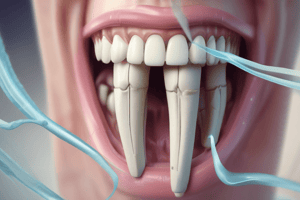Podcast
Questions and Answers
Sodium hypochlorite (NaOCl) is the only bactericidal irrigant used in endodontics.
Sodium hypochlorite (NaOCl) is the only bactericidal irrigant used in endodontics.
False (B)
Chelating agents such as EDTA and citric acid are used to dissolve inorganic residues and improve penetration of antimicrobial solutions.
Chelating agents such as EDTA and citric acid are used to dissolve inorganic residues and improve penetration of antimicrobial solutions.
True (A)
A 0.5% concentration of NaOCl is considered the most effective against a broad spectrum of microorganisms in the root canal system.
A 0.5% concentration of NaOCl is considered the most effective against a broad spectrum of microorganisms in the root canal system.
False (B)
The use of hydrogen peroxide (H2O2) at a concentration of 3% can cause oxidative stress to pulpal cells, necessitating careful application.
The use of hydrogen peroxide (H2O2) at a concentration of 3% can cause oxidative stress to pulpal cells, necessitating careful application.
Saline solution and local anesthetics are classified as bactericidal irrigants in endodontics.
Saline solution and local anesthetics are classified as bactericidal irrigants in endodontics.
Study Notes
Irrigants in Endodontics: Enhancing the Effectiveness of Root Canal Treatment
Endodontic treatment aims to remove bacterial pathogens and disinfect the root canal system to promote healing. While mechanical instrumentation plays a crucial role in shaping the root canal, it alone cannot achieve complete disinfection due to the complex morphology of the root canal system. Therefore, chemical solutions called irrigants are employed to complement the mechanical process and enhance overall treatment success. This article explores the key concepts surrounding endodontic irrigants, their classification, and their roles in achieving successful root canal treatments.
Role of Irrigants in Endodontics
Irrigation serves multiple purposes in endodontic therapy. It assists in:
- Removing tissue remnants and dentin chips left behind after instrumentation.
- Flushing away microorganisms and yeasts, which are difficult to reach with instruments.
- Preventing packing of hard and soft tissues within the apical root canal, thus reducing the risk of extrusion into surrounding tissues.
- Enhancing the penetration of antimicrobials administered during treatment.
- Supporting the action of intracanal medicaments used between appointments.
The goal is to optimize root canal disinfection while minimizing potential complications such as damage to periapical tissues.
Classification of Endodontic Irrigants
Irrigants in endodontics can be classified based on their mechanism of action:
Non-bactericidal Irrigants
These include:
- Saline solution
- Local anesthetics
- Distilled water
They primarily serve to provide lubrication during instrumentation and to dissolve organic debris present in the root canal system.
Bactericidal Irrigants
Bactericidal irrigants possess antimicrobial properties and directly kill or inhibit the growth of bacteria in the root canal system. Examples include:
Sodium hypochlorite (NaCl)
Available in varying concentrations (e.g., 0.5%, 1%, 1.5%, 2.5%, 5.25%, and 6%), NaCl is effective against a broad spectrum of microorganisms and has a high penetrating ability. However, its use may lead to chemically induced inflammation if not carefully controlled, causing pain for patients and compromising treatment outcomes.
Chlorhexidine gluconate (CHX)
Used at a concentration of 2%, CHX is relatively stable in the presence of calcium hydroxide and has low toxicity to pulpal cells. Its efficacy against many causative agents of endodontic disease makes it a popular choice for irrigation and topical application.
Iodine
Iodine has strong antiseptic effects but its use in endodontics is limited due to its possible cytotoxicity and staining of teeth and dental materials.
Hydrogen peroxide (H2O2)
At a concentration of 3%, H2O2 provides an oxygen environment that can cause non-enzymatic oxidation of lipids and proteins, contributing to the antibacterial effect. However, it can also cause oxidative stress to pulpal cells, necessitating careful use.
Chelating Agents
Chelating agents like ethylene diamine tetra acetic acid (EDTA) and citric acid are employed as irrigants in endodontics due to their ability to dissolve inorganic residues such as calcium hydroxide, promoting better penetration of other antimicrobial solutions. They are often used in combination with bactericidal agents for enhanced disinfection efficacy.
Advantages and Limitations of Endodontic Irrigants
The choice of an appropriate irrigation protocol depends on factors such as the specific condition of the root canal system, patient tolerance, and expected treatment outcomes. A well-designed irrigation regimen should:
- Efficiently remove debris and microorganisms from the complex morphology of the root canal system.
- Minimize adverse effects on periapical tissues.
- Provide a balance between disinfection and preserving healthy tissues.
In conclusion, the selection and application of endodontic irrigants play a critical role in achieving successful root canal treatments. Optimal irrigation is achieved by combining different types of irrigants in a sequential manner to achieve safe and effective disinfection of the root canal system while minimizing potential complications. As research continues to advance our understanding of bacterial pathogens and root canal anatomy, novel irrigants and delivery systems will likely emerge to further optimize endodontic treatment outcomes.
Studying That Suits You
Use AI to generate personalized quizzes and flashcards to suit your learning preferences.
Description
Explore the role of irrigants in endodontics and their classification based on their mechanism of action. Learn how irrigants assist in disinfecting the root canal system, preventing complications, and supporting successful root canal treatments.




